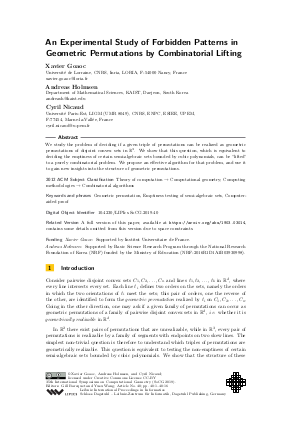An Experimental Study of Forbidden Patterns in Geometric Permutations by Combinatorial Lifting
Authors Xavier Goaoc, Andreas Holmsen, Cyril Nicaud
-
Part of:
Volume:
35th International Symposium on Computational Geometry (SoCG 2019)
Part of: Series: Leibniz International Proceedings in Informatics (LIPIcs)
Part of: Conference: Symposium on Computational Geometry (SoCG) - License:
 Creative Commons Attribution 3.0 Unported license
Creative Commons Attribution 3.0 Unported license
- Publication Date: 2019-06-11
File

PDF
LIPIcs.SoCG.2019.40.pdf
- Filesize: 0.73 MB
- 16 pages
Document Identifiers
Related Versions
-
A full version of this paper, available at https://arxiv.org/abs/1903.03014, contains some details omitted from this version due to space constraints.
Subject Classification
ACM Subject Classification
- Theory of computation → Computational geometry
- Computing methodologies → Combinatorial algorithms
Keywords
- Geometric permutation
- Emptiness testing of semi-algebraic sets
- Computer-aided proof
Metrics
- Access Statistics
-
Total Accesses (updated on a weekly basis)
0Document
0Metadata
Abstract
We study the problem of deciding if a given triple of permutations can be realized as geometric permutations of disjoint convex sets in R^3. We show that this question, which is equivalent to deciding the emptiness of certain semi-algebraic sets bounded by cubic polynomials, can be "lifted" to a purely combinatorial problem. We propose an effective algorithm for that problem, and use it to gain new insights into the structure of geometric permutations.
Cite As Get BibTex
Xavier Goaoc, Andreas Holmsen, and Cyril Nicaud. An Experimental Study of Forbidden Patterns in Geometric Permutations by Combinatorial Lifting. In 35th International Symposium on Computational Geometry (SoCG 2019). Leibniz International Proceedings in Informatics (LIPIcs), Volume 129, pp. 40:1-40:16, Schloss Dagstuhl – Leibniz-Zentrum für Informatik (2019)
https://doi.org/10.4230/LIPIcs.SoCG.2019.40
BibTex
@InProceedings{goaoc_et_al:LIPIcs.SoCG.2019.40,
author = {Goaoc, Xavier and Holmsen, Andreas and Nicaud, Cyril},
title = {{An Experimental Study of Forbidden Patterns in Geometric Permutations by Combinatorial Lifting}},
booktitle = {35th International Symposium on Computational Geometry (SoCG 2019)},
pages = {40:1--40:16},
series = {Leibniz International Proceedings in Informatics (LIPIcs)},
ISBN = {978-3-95977-104-7},
ISSN = {1868-8969},
year = {2019},
volume = {129},
editor = {Barequet, Gill and Wang, Yusu},
publisher = {Schloss Dagstuhl -- Leibniz-Zentrum f{\"u}r Informatik},
address = {Dagstuhl, Germany},
URL = {https://drops.dagstuhl.de/entities/document/10.4230/LIPIcs.SoCG.2019.40},
URN = {urn:nbn:de:0030-drops-104442},
doi = {10.4230/LIPIcs.SoCG.2019.40},
annote = {Keywords: Geometric permutation, Emptiness testing of semi-algebraic sets, Computer-aided proof}
}
Author Details
Funding
- Goaoc, Xavier: Supported by Institut Universitaire de France.
- Holmsen, Andreas: Supported by Basic Science Research Program through the National Research Foundation of Korea (NRF) funded by the Ministry of Education (NRF-2016R1D1A1B03930998).
References
-
B Aronov and S. Smorodinsky. On geometric permutations induced by lines transversal through a fixed point. Discrete &Computational Geometry, 34:285-294, 2005.

- Andrei Asinowski and Meir Katchalski. Forbidden Families of Geometric Permutations in ℝ^d. Discrete & Computational Geometry, 34(1):1-10, 2005. URL: http://dx.doi.org/10.1007/s00454-004-1110-x.
-
O. Cheong, X. Goaoc, and H.-S. Na. Geometric permutations of disjoint unit spheres. Computational Geometry: Theory &Applications, 30:253-270, 2005.

- Felipe Cucker, Peter Bürgisser, and Pierre Lairez. Computing the homology of basic semialgebraic sets in weak exponential time. arXiv preprint, 2017. URL: http://arxiv.org/abs/1706.07473.
-
James H Davenport and Joos Heintz. Real quantifier elimination is doubly exponential. Journal of Symbolic Computation, 5(1-2):29-35, 1988.

-
Herbert Edelsbrunner and Micha Sharir. The maximum number of ways to stab n convex non-intersecting sets in the plane is 2n-2. Discrete &Computational Geometry, 5:35-42, 1990.

-
B. Grünbaum. On common transversals. Archiv der Mathematik, 9:465-469, 1958.

-
Philippe Guigue and Olivier Devillers. Fast and robust triangle-triangle overlap test using orientation predicates. Journal of graphics tools, 8(1):25-32, 2003.

-
Jae-Soon Ha, Otfried Cheong, Xavier Goaoc, and Jungwoo Yang. Geometric permutations of non-overlapping unit balls revisited. Computational Geometry, 53:36-50, 2016.

-
Andreas Holmsen and Rephael Wenger. Helly-type Theorems and geometric transversals. Handbook of discrete and computational geometry, CRC Press Ser. Discrete Math. Appl, pages 63-82, 2017.

-
Erich Kaltofen, Bin Li, Zhengfeng Yang, and Lihong Zhi. Exact certification in global polynomial optimization via sums-of-squares of rational functions with rational coefficients. J. Symb. Comput., 47(1):1-15, 2012.

-
M Katchalski. A conjecture of Grünbaum on common transversals. Math. Scand., 59:192-198, 1986.

-
M. Katchalski, T. Lewis, and J. Zaks. Geometric permutations for convex sets. Discrete Math., 54:271-284, 1985.

-
M Katchalski, Ted Lewis, and A Liu. Geometric permutations and common transversals. Discrete &Computational Geometry, 1(4):371-377, 1986.

-
Jan Kratochvíl and Jirí Matousek. Intersection graphs of segments. J. Comb. Theory, Ser. B, 62(2):289-315, 1994.

- Henri Lombardi, Daniel Perrucci, and Marie-Françoise Roy. An elementary recursive bound for effective Positivstellensatz and Hilbert 17-th problem. arXiv preprint, 2014. URL: http://arxiv.org/abs/1404.2338.
-
A. Marcus and G. Tardos. Excluded permutation matrices and the Stanley-Wilf conjecture. J. Combin. Theory Ser. A, 107:153-160, 2004.

-
János Pach and Micha Sharir. Combinatorial geometry and its algorithmic applications: The Alcalá lectures. 152. American Mathematical Soc., 2009.

-
James Renegar. On the computational complexity and geometry of the first-order theory of the reals. Part I: Introduction. Preliminaries. The geometry of semi-algebraic sets. The decision problem for the existential theory of the reals. Journal of symbolic computation, 13(3):255-299, 1992.

-
Natan Rubin, Haim Kaplan, and Micha Sharir. Improved bounds for geometric permutations. SIAM Journal on Computing, 41(2):367-390, 2012.

-
Marcus Schaefer and Daniel Štefankovič. Fixed points, Nash equilibria, and the existential theory of the reals. Theory of Computing Systems, 60(2):172-193, 2017.

-
S. Smorodinsky, J.S.B Mitchell, and M. Sharir. Sharp bounds on geometric permutations for pairwise disjoint balls in ℝ^d. Discrete &Computational Geometry, 23:247-259, 2000.

-
Csaba D Toth, Joseph O'Rourke, and Jacob E Goodman. Handbook of discrete and computational geometry. Chapman and Hall/CRC, 2017.

-
H. Tverberg. Proof of Grünbaum’s conjecture on common transversals for translates. Discrete &Computational Geometry, 4:191-203, 1989.

-
Helge Tverberg. On geometric permutations and the Katchalski-Lewis conjecture on partial transversals for translates. DIMACS Ser. Discrete Math. Theor. Comp. Sci., 6:351-361, 1991.

